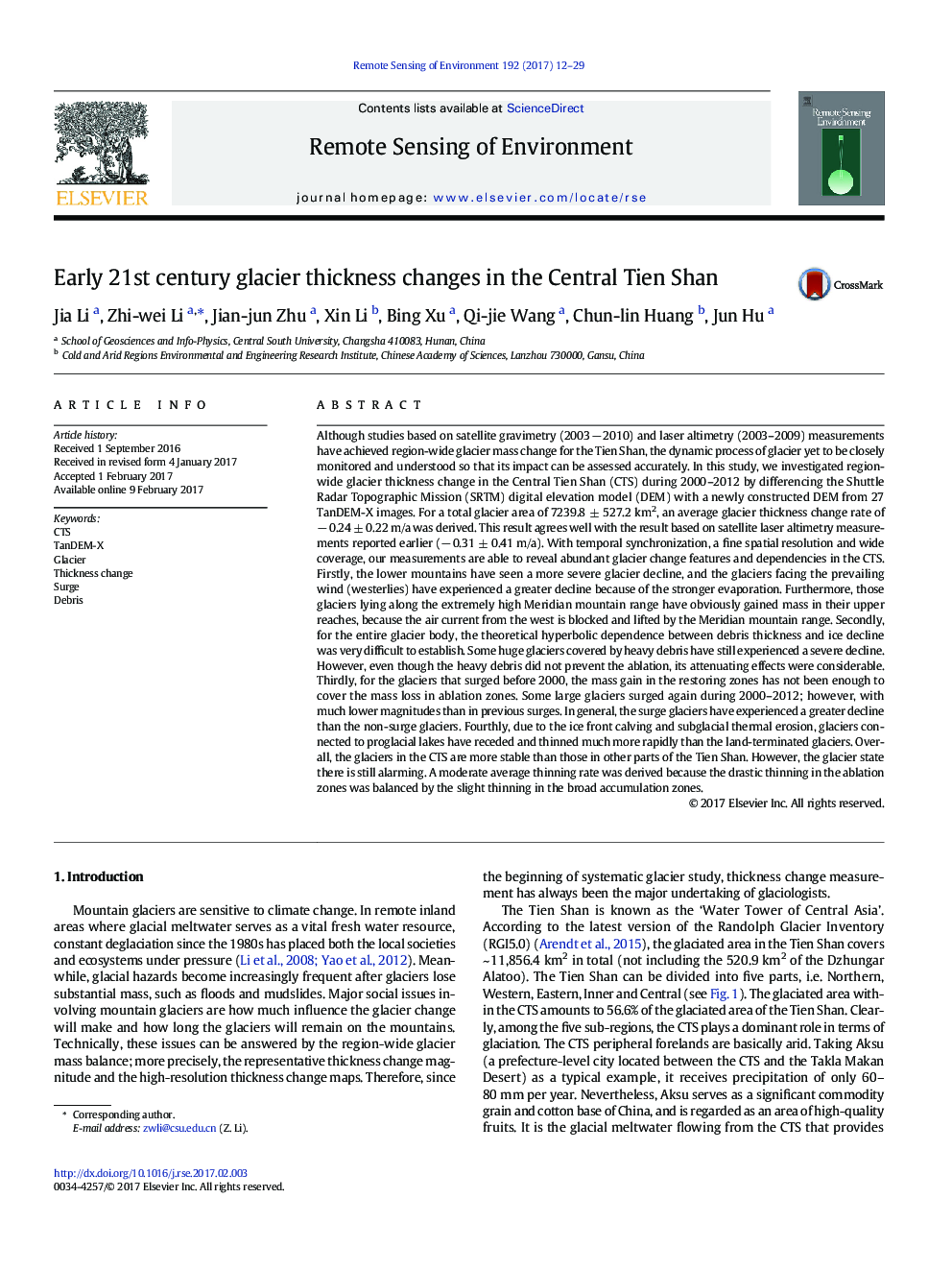| کد مقاله | کد نشریه | سال انتشار | مقاله انگلیسی | نسخه تمام متن |
|---|---|---|---|---|
| 5754867 | 1621208 | 2017 | 18 صفحه PDF | دانلود رایگان |
عنوان انگلیسی مقاله ISI
Early 21st century glacier thickness changes in the Central Tien Shan
ترجمه فارسی عنوان
ضخامت یخچال قرن بیستم در مرکز تین شان تغییر می کند
دانلود مقاله + سفارش ترجمه
دانلود مقاله ISI انگلیسی
رایگان برای ایرانیان
کلمات کلیدی
موضوعات مرتبط
مهندسی و علوم پایه
علوم زمین و سیارات
کامپیوتر در علوم زمین
چکیده انگلیسی
Although studies based on satellite gravimetry (2003 â 2010) and laser altimetry (2003-2009) measurements have achieved region-wide glacier mass change for the Tien Shan, the dynamic process of glacier yet to be closely monitored and understood so that its impact can be assessed accurately. In this study, we investigated region-wide glacier thickness change in the Central Tien Shan (CTS) during 2000-2012 by differencing the Shuttle Radar Topographic Mission (SRTM) digital elevation model (DEM) with a newly constructed DEM from 27 TanDEM-X images. For a total glacier area of 7239.8 ± 527.2 km2, an average glacier thickness change rate of â 0.24 ± 0.22 m/a was derived. This result agrees well with the result based on satellite laser altimetry measurements reported earlier (â 0.31 ± 0.41 m/a). With temporal synchronization, a fine spatial resolution and wide coverage, our measurements are able to reveal abundant glacier change features and dependencies in the CTS. Firstly, the lower mountains have seen a more severe glacier decline, and the glaciers facing the prevailing wind (westerlies) have experienced a greater decline because of the stronger evaporation. Furthermore, those glaciers lying along the extremely high Meridian mountain range have obviously gained mass in their upper reaches, because the air current from the west is blocked and lifted by the Meridian mountain range. Secondly, for the entire glacier body, the theoretical hyperbolic dependence between debris thickness and ice decline was very difficult to establish. Some huge glaciers covered by heavy debris have still experienced a severe decline. However, even though the heavy debris did not prevent the ablation, its attenuating effects were considerable. Thirdly, for the glaciers that surged before 2000, the mass gain in the restoring zones has not been enough to cover the mass loss in ablation zones. Some large glaciers surged again during 2000-2012; however, with much lower magnitudes than in previous surges. In general, the surge glaciers have experienced a greater decline than the non-surge glaciers. Fourthly, due to the ice front calving and subglacial thermal erosion, glaciers connected to proglacial lakes have receded and thinned much more rapidly than the land-terminated glaciers. Overall, the glaciers in the CTS are more stable than those in other parts of the Tien Shan. However, the glacier state there is still alarming. A moderate average thinning rate was derived because the drastic thinning in the ablation zones was balanced by the slight thinning in the broad accumulation zones.
ناشر
Database: Elsevier - ScienceDirect (ساینس دایرکت)
Journal: Remote Sensing of Environment - Volume 192, April 2017, Pages 12-29
Journal: Remote Sensing of Environment - Volume 192, April 2017, Pages 12-29
نویسندگان
Jia Li, Zhi-wei Li, Jian-jun Zhu, Xin Li, Bing Xu, Qi-jie Wang, Chun-lin Huang, Jun Hu,
